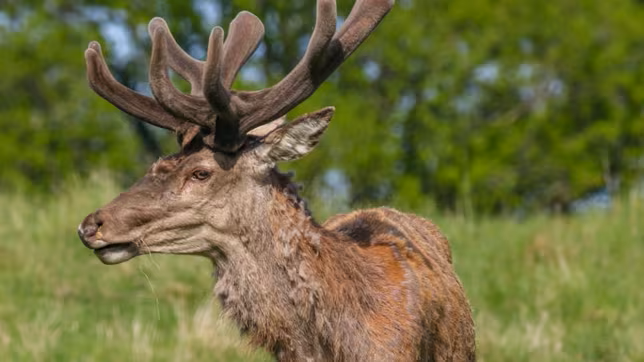What is the ‘Zombie’ disease impacting the US deer population
Scientists warn that deadly disease devastating deer populations in the US could pose risk to humans

Your support helps us to tell the story
From reproductive rights to climate change to Big Tech, The Independent is on the ground when the story is developing. Whether it's investigating the financials of Elon Musk's pro-Trump PAC or producing our latest documentary, 'The A Word', which shines a light on the American women fighting for reproductive rights, we know how important it is to parse out the facts from the messaging.
At such a critical moment in US history, we need reporters on the ground. Your donation allows us to keep sending journalists to speak to both sides of the story.
The Independent is trusted by Americans across the entire political spectrum. And unlike many other quality news outlets, we choose not to lock Americans out of our reporting and analysis with paywalls. We believe quality journalism should be available to everyone, paid for by those who can afford it.
Your support makes all the difference.A horrific disease has been taking hold of deer across the US, leaving them debilitated by slowly shutting down their bodies.
The first case in Yellowstone National Park was recently discovered in an adult male mule deer, with hundreds more cases revealed soon after.
Now, scientists have warned that the disease could spread to humans in a “slow-moving disaster”.
Here is everything we know about this illness.
What is the ‘zombie deer’ disease?
Chronic wasting disease, otherwise known as “zombie deer” disease, is part of a family of prion illnesses – where a type of protein folded in an obscure way can cause other proteins to fold in the same way, leading to cellular death, according to the Centers for Disease Control and Prevention (CDC).
These rare illnesses are known for their long incubation periods that eventually affect how the brain functions.
Versions of prion diseases can affect humans, but it’s more typical among animals.
In this case, the Animal and Plant Inspection Service says chronic wasting disease has so far only been recorded as naturally occurring in deer, reindeer, moose and elk.
The CDC said the disease has been known to make deer lose weight drastically, stumble around, lose energy and other neurologic symptoms, but it may take over a year after contraction for this to develop.
There are currently no treatments or vaccines for this disease.
Sometimes, deer will die without ever developing the zombie-like symptoms.
Norway, Finland and Sweden and a small number of imported cases in South Korea have been recorded in reindeer and moose.
As of November 2023, there had been cases of chronic wasting disease in free-ranging deer, elk and moose in at least 31 states in the US, as well as three provinces in Canada, according to the CDC.
Yet this disease is not a new occurrence; the first identified case of chronic wasting disease was in captive deer in a Colorado research facility in the late 1960s, then in wild deer in 1981.

By the 1990s, Colorado and Wyoming saw cases spreading, which has now spread further across the country. Other states without robust wildlife surveillance may be affected, but cases have not been confirmed.
The CDC expects the affected areas to continue to expand; in some of the most densely affected areas, infection rates may exceed one in 10 deer and elk.
In one captive deer herd, it is reported that the rates were much higher, four in five, which suggests a greater risk than wild deer.
Chronic wasting disease is thought to be spread between the animals directly or indirectly through bodily fluids such as faeces, saliva, blood, and urine, such as through the same food or water source. The disease is highly contagious and can spread quickly, especially within captive herds.
No known cases of chronic wasting disease have affected humans, according to the CDC, but initial studies are underway to determine if the disease can spread to human bodies.
Experts have warned the disease was a “slow-moving disaster” and urged governments to prepare for the possibility of it spreading to humans.
“The mad cow disease outbreak in Britain provided an example of how, overnight, things can get crazy when a spillover event happens from, say, livestock to people,” CWD researcher Dr Cory Anderson told The Guardian.
“We’re talking about the potential of something similar occurring. No one is saying that it’s definitely going to happen, but it’s important for people to be prepared.”
Despite the lack of cases, scientists have been studying if prion diseases could be occurring at a higher rate in people who are in contact with or eat elk or deer meat, but due to the long incubation periods of the illness, it may be years before any risks are discovered.
Apart from humans, for animals not from the Cervid family (deer, moose and elk), experimental research has found that chronic wasting disease as infected squirrel monkeys and laboratory mice that carry some human genes, reports the CDC.
Testing was also carried out on macaques, a monkey that is the most genetically similar to humans out of any animal and was found to be infected by chronic wasting disease after being fed infected deer meat.
While little is known about chronic wasting disease and human exposure, the CDC has recommended that hunters should test meat they have caught from deer, especially in areas where chronic wasting disease is rife.
To be extra cautious, people are also advised to avoid sick-looking animals, wear protective gear and latex gloves when handling the animal or its meat, minimise the handling of organs, and not use household utensils while field dressing.
Join our commenting forum
Join thought-provoking conversations, follow other Independent readers and see their replies
Comments